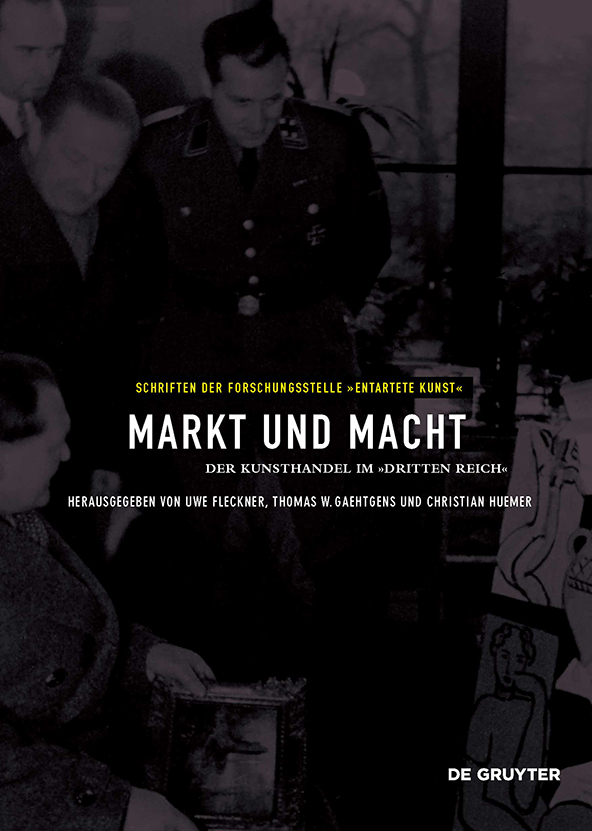BOOK:Markt und Macht,De Gruyter Publications
 In 2012, German authorities found 1,500artworks from Paul Rosenberg’s Collection in an apartment rented by Cornelius Gurlitt, son of 1930s German art dealer Hildebrand Gurlitt, in Munich. In the period 1933-45 the Nazis orchestrated the most massive art theft in world history. A huge number of artworks looted by the Nazis are still missing. They have been spread around the world through a variety of different channels and can still be found in the art market. Writing the history of art dealing in the Third Reich presents a special challenge, not only because of the difficult situation regarding source material. The book Markt und Macht-Der Kunsthandel im “Dritten Reich” (Market and Power-The Art Trade in the “Third Reich”) by De Gruyter Publications, is a cooperation between the Forschungsstelle “Entartete Kunst”, Hamburg, and the Getty Research Institute, Los Angeles. Art historians and economic historians investigate the art market and its mechanisms under National Socialism, the role of art theft and, in particular, that of modern and “Degenerate” works of art in the art market. The range of issues includes the day-to-day business of art dealers through to the resistance to restrictive regulations, from auction trade through to black market, from numerous crimes involving not only Jewish collectors and dealers, through to art theft in countries occupied by German forces. Among the caseς that are examined is the Paul Rosenberg Collection case. In July 1940, Nazi Alfred Rosenberg established the Parisian base of the Einsatzstab Reichsleiter Rosenberg (ERR), whose purpose was to confiscate the highest-quality works of art for Hitler’s planned Führermuseum in Linz, Austria. All looted art works, including Paul Rosenberg’s, were initially shipped to the depot created in the Galerie nationale du Jeu de Paume. There Nazi art historians, experts, photographers, and maintenance and administrative personnel appraised, filed, photographed and packed what were now termed “ownerless cultural goods” for rail transport to Germany. Because the Nazis banned “Degenerate Art” from entering Germany, art so designated in France was looted and held in what became known as the “Martyr’s Room”. Following Joseph Goebels personal directive to sell these degenerate works for foreign currency to fund the building of the Führermuseum and the wider war effort, Hermann Göring appointed a series of ERR-approved dealers to liquidate these assets.-Dimitris Lempesis
In 2012, German authorities found 1,500artworks from Paul Rosenberg’s Collection in an apartment rented by Cornelius Gurlitt, son of 1930s German art dealer Hildebrand Gurlitt, in Munich. In the period 1933-45 the Nazis orchestrated the most massive art theft in world history. A huge number of artworks looted by the Nazis are still missing. They have been spread around the world through a variety of different channels and can still be found in the art market. Writing the history of art dealing in the Third Reich presents a special challenge, not only because of the difficult situation regarding source material. The book Markt und Macht-Der Kunsthandel im “Dritten Reich” (Market and Power-The Art Trade in the “Third Reich”) by De Gruyter Publications, is a cooperation between the Forschungsstelle “Entartete Kunst”, Hamburg, and the Getty Research Institute, Los Angeles. Art historians and economic historians investigate the art market and its mechanisms under National Socialism, the role of art theft and, in particular, that of modern and “Degenerate” works of art in the art market. The range of issues includes the day-to-day business of art dealers through to the resistance to restrictive regulations, from auction trade through to black market, from numerous crimes involving not only Jewish collectors and dealers, through to art theft in countries occupied by German forces. Among the caseς that are examined is the Paul Rosenberg Collection case. In July 1940, Nazi Alfred Rosenberg established the Parisian base of the Einsatzstab Reichsleiter Rosenberg (ERR), whose purpose was to confiscate the highest-quality works of art for Hitler’s planned Führermuseum in Linz, Austria. All looted art works, including Paul Rosenberg’s, were initially shipped to the depot created in the Galerie nationale du Jeu de Paume. There Nazi art historians, experts, photographers, and maintenance and administrative personnel appraised, filed, photographed and packed what were now termed “ownerless cultural goods” for rail transport to Germany. Because the Nazis banned “Degenerate Art” from entering Germany, art so designated in France was looted and held in what became known as the “Martyr’s Room”. Following Joseph Goebels personal directive to sell these degenerate works for foreign currency to fund the building of the Führermuseum and the wider war effort, Hermann Göring appointed a series of ERR-approved dealers to liquidate these assets.-Dimitris Lempesis
